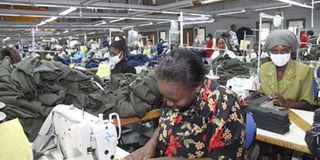Premium
We should revive our textile industry for fashion to thrive

A textile worker in Altex EPZ Textile Manufacturing for foreign markets at Athi River. The forlorn Kenyan textile industry is depriving us of a necessary, delicious pleasure! PHOTO | FILE
What you need to know:
- Sabine told the conference, “Creative people love to play tricks with our natural reactions,” showcasing next-generation trends such as lace that feels nothing like lace and more like air, fabrics with an air conditioning, cooling effect, soft and hairy textures, interesting faux fur, woolie softness and stretch and skin-like membrane sensations like peeling an egg.
- When you grasp that fabric is what determines the function of an outfit, the context upon which it shall be worn, you begin to get our warped, beyond late adopter picture.
- At an earlier Fashion Focus Group in KikoRomeo, emerging designers disclosed a struggle finding variety in fabric, instead recycling what has been discarded on the tail end of Western seasons. It means in effect that from the go, we are several beats behind.
It is entirely possible I stumbled across the missing ingredient in the Kenyan fashion industry.
I suspect it happened precisely when Sabine Le Chatelier said that “Fashion isn’t just about eye catching but hand catching too.”
Chatelier, an Associate Fashion Director of Première Vision, a leading fabric fair and trends observer, made the remark at the second P&G Future Fabrics meeting this month in Berlin, Germany.
“The ultimate luxury of silk, the noisiness of denim, opulence of a cashmere coat, the scent of leather — you receive messages then feel them through the fabric.”
As such, the forlorn Kenyan textile industry is depriving us of a necessary, delicious pleasure!
First off, Sabine confirms 2015 will be an extension of “Engineers teaming up to invest in new sensations creating new, deliberately unfamiliar sensations,” adding that “Trendiness is impacted by fabric senses. Even the use of phrases like good taste and bad taste are dictated by the senses which convey a perception of quality.”
These storytelling surfaces make our closets unique. Go to yours right now. Notice how multi-textural it is. You are drawn to varied sensorial experiences each time you shop. The industry knows this.
DRY CLEAN ONLY
Sabine told the conference, “Creative people love to play tricks with our natural reactions,” showcasing next-generation trends such as lace that feels nothing like lace and more like air, fabrics with an air conditioning, cooling effect, soft and hairy textures, interesting faux fur, woolie softness and stretch and skin-like membrane sensations like peeling an egg.
Now more than ever it is vital that we develop our textile industry. Individuality is increasingly being valued as an asset with fabric acknowledged as living material. We have considerable distance to cover. Mary Katrantzou, Greek fashion and textile designer said; “Designers should be at the forefront of textile innovation.
It could be self-taught, collaborate with people to do this, think outside the box and design; then teach textile mills about this fabric.”
Mary gave a fine example of sketches designers make before each season which at first glance indicated a disconnect with the textile industry. They sketch outfits designed to do things existing fabrics cannot, requiring a whole new skill set in a vastly untapped, uncharted territory.
“When designers don’t understand fabric, it shows. They make an exquisite outfit and then plaster a label reading “dry clean only.”
The dry cleaner has no clue what he is about to get himself into. The result is fabric that costs $300 (Sh27,000) to $500 (Sh45,000) and plenty of hours, usually done by hand, is damaged because the client doesn’t know any better and neither does the dry cleaner.
The first point of contact is with the designer. Clients expect us to be experts but if we don’t understand fabric then who are they supposed to turn to?
Designers owe it to their clients. It demands an inquisitive nature, putting heads together, expanding training in design courses.
At an earlier Fashion Focus Group in KikoRomeo, emerging designers disclosed a struggle finding variety in fabric, instead recycling what has been discarded on the tail end of Western seasons. It means in effect that from the go, we are several beats behind.
When you grasp that fabric is what determines the function of an outfit, the context upon which it shall be worn, you begin to get our warped, beyond late adopter picture.
Mary’s adidas collection incidentally, is made from neoprene, synthetic rubbers. The award-winning designer’s fashion history is littered with examples of experimental fabrics and riddled with curiosities as well as self-confessed risks and disasters. She’s 31.
LAGGING BEHIND
There’s really great news though.
CNBC reported last month that “Chinese firm Jiangsu Lianfa Textile Company Limited has committed to build a textile plant in Kenya.” This 50,000 acre plant located in Naivasha “will cost Sh44 billion.”
In August 2014, CNBC also reported, “the Export-Import Bank of India said it will provide funding worth Sh 7.9 billion for the expansion of Rift Valley Textile Company Ltd; once the Indian government agrees to the proposal.”
A Kenya Association of Manufacturers’ 2009 report listed major factors afflicting our textile industry such as: the high cost of electricity accounting for 35 per cent of the cost of fabric production, delays caused by congestion at the port of Mombasa, poor roads blamed, influx of cheap imports from Asia, mitumba and the limited raw materials.
A comprehensive paper by African Cotton and Textiles Industries Federation (ACTIF) offers detailed recommendations for East Africa.
Ethiopia, Uganda and Tanzania kick our butts on this one. The fashion world grows more imaginative and exciting with fabric look, feel, behavior and handling as the foundation of creativity.
But Kenya is lagging behind and we need to be more than a little concerned.





